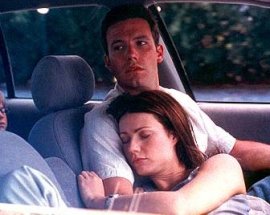 BOUNCE
BOUNCE
Writer-director Don Roos might never be a great filmmaker - his staging is obvious in that Kevin Smith way (a lot of two-shots of characters talking) and there's no real visual life on display. But he's wonderful with actors, and he has a great ear for dialogue, writing realistic lines that can flip in a moment's notice to something truly comic or poignant.
The best thing about his joyous 1998 film The Opposite of Sex was its quick-flip dexterity between the outrageous and the mundane, and he shows a lot of that same spark in his latest, the romantic comedy/drama Bounce. It's a predictable enough Hollywood romance, but it has more feeling than we're used to seeing in films of this ilk, and stars Ben Affleck and Gwyneth Paltrow deliver the most soulful performances we've yet seen from them.
Affleck plays hotshot ad exec Buddy Amaral, who, for mostly selfish reasons, trades plane tickets with a businessman (Tony Goldwyn) trying to get home to his family. The plane crashes, killing everyone onboard, and Buddy spirals into depression and alcoholism, unable to deal with how close he came to death, and how he inadvertently caused someone else's. Recovering a year later, and trying to get some closure on the event, Buddy pays a visit to the businessman's widow, Abby (Paltrow), and the two begin a tentative romance. Abby, though, doesn't know the circumstances that brought Buddy to her. Will he tell her? Well ... it's a movie, so of course he does. The true question that lingers is: What will happen when he does?
This plot is pure Hollywood formula, one of those setups that feels like you've seen it before even when you haven't. And Roos can't quite sidestep the clichés that invariably come with it, such as Buddy's eventual bonding with Abby's kids, Abby's confessions about how Buddy is "too good to be true," and Buddy's soul-searching as he decides whether in fact he should spill the beans. But none of this really matters because Roos has written beautifully calibrated dialogue for his leads (along with some truly witty banter for the film's supporting actors, like the terrific Johnny Galecki and Caroline Aaron), and Affleck and Paltrow are so endearing that you really want them to find happiness. Bounce might be predictable, even typical, but it's not cynical.
Those of us who've been waiting for Ben Affleck to return to his Chasing Amy mode, before he became wrapped up in Paul Newman-lite Movie Star mode, will be thrilled to watch the tenderness and passion he brings to his performance, and Paltrow is radiant even when Abby is mired in sadness; there's a true life force there, and it gives the romance, and the film itself, resonance. Bounce is a slight thing, maybe too slight, but it avoids mawkishness and neat sentiment, and after the year's unfairly neglected Keeping the Faith, it's the best Hollywood romance of the year.
 DR. SEUSS' HOW THE GRINCH STOLE CHRISTMAS
DR. SEUSS' HOW THE GRINCH STOLE CHRISTMAS
Examined strictly as a movie experience, Dr. Seuss' How the Grinch Stole Christmas isn't terrible, exactly. It allows Jim Carrey more than enough comic leeway (even while buried under Rick Baker's marvelous make-up), director Ron Howard does his best to give the film a highly stylized atmosphere, and Lord knows there's always something to look at - some elaborate bit of set design or some outré costuming or SNL vet Molly Shannon. It's a visual feast, and with Carrey in charge, sometimes a verbal one; no one is likely to leave the movie theatre thinking they didn't get their money's worth. The problem is, at least for those of us who vividly remember the story from our youth, that Howard's film can't possibly be viewed strictly as a movie experience; for many, Dr. Seuss' work was a profound life experience. And examined as an adaptation of the wonderful children's book (and the classic 1966 animated film that followed), this Grinch is often woefully inept.
Seuss' spirit is all but invisible in this production, and the constant barrage of modern-day items and references makes no sense given what Howard is trying to accomplish with the otherworldliness of Whoville. When we see the Whos (who come off as oddly hateful and piggish) with fax machines, or listen to the Grinch call someone "dude," it comes off as such a blatant attempt to keep adults - or rather, teenagers - interested that you come to hate the modernization more and more; if you can't trust the spirit of Dr. Seuss to guide your holiday family film, what's the point? And the film is so bloated with unnecessary subplots and extraneous material that all sense of Seuss' economy and brevity is, unsurprisingly, gone. The actual story of "How the Grinch Stole Christmas" only takes up the last half hour of the film's 110-minute running length; the rest is devoted to the Grinch's backstory (were any of us curious about what the Grinch was like as a child?) and minor activities designed to get the plot in motion. If an hour has passed and the film is still trying to rev up the plot, you know you're in trouble. Tellingly, the film's last half hour is its best; it achieves some momentum, and Carrey starts playing the story as "realistically" as possible given the circumstances. Ideally, the film should have been a mere 30-ish minutes long - it could have been a wickedly entertaining, though insanely expensive, short film for TV.
It's tempting to say that no one could have played the Grinch like Jim Carrey, but that's not quite accurate - no one could have played the Grinch like this like Jim Carrey. It's to his credit that he never gets lost underneath that suit - you're always aware that Master Comic Jim Carrey is there - but that's also a big part of the problem; this Grinch is more whiz-bang comic powerhouse than figure of selfishness and terror, and so there doesn't appear to be much at stake when he decides to steal Christmas from the Whos. (Some Seuss-philes might be offended that little Cindy Lou Who, played by ultra-cute Taylor Momsen, spends most of her screen time laughing at the Grinch, but it seemed to me the only reasonable thing to do.) On its own terms, this Grinch might work, and will surely be a huge hit, but make no mistake: This isn't Dr. Seuss' How the Grinch Stole Christmas; it's Jim Carrey's How the Grinch Stole Christmas. If you're jonesing for a Jim Carrey vehicle, this'll do the trick; if you're looking for an adaptation that matches the one you have in your head, you're better off with the original goods.










